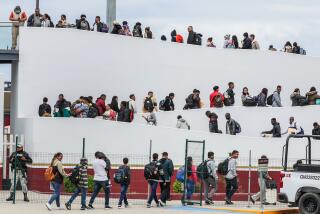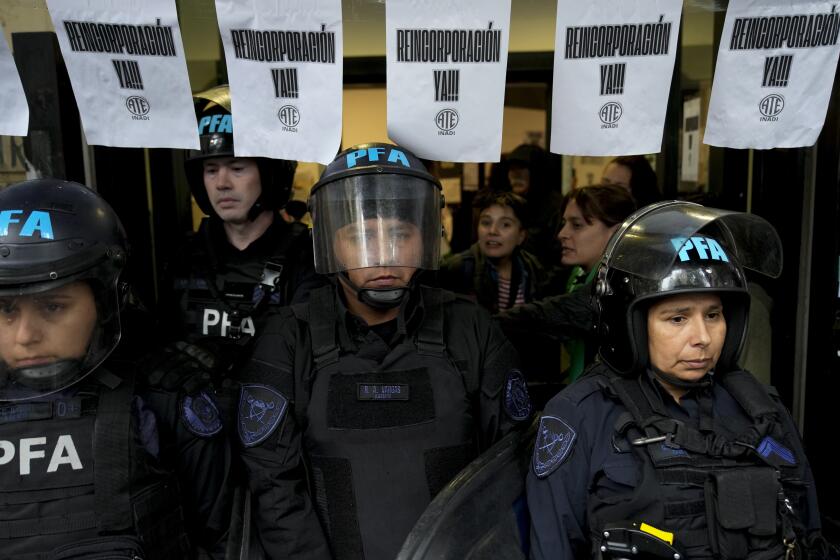The Ruble Gets Respectable--at Least for Now : Russia: Currency doubles in value against the dollar. But some see a ‘game,’ while panic seizes owners of dollars.
The concerned madam of a Paris brothel raced down the corridor when she heard one of her girls crying, “No, Monsieur! No! Anything but that!” She threw open the bedroom door only to find a true outrage--a Russian client attempting to pay in rubles.
That well-worn Russian joke may soon stop making the rounds here.
The ruble, a currency so despised that many Russians refer contemptuously to their bills as derevyashki , or “wooden ones,” has undergone a sudden meteoric rise in relation to the dollar.
In what Russian officials tout as the first major breakthrough of their economic reforms, the ruble virtually doubled in value in the last month--from almost 140 to the dollar to about 70--and the government is predicting that, with some fluctuations, it will reach 50 rubles to the dollar in coming weeks.
“This is a supremely important indicator of the success of the reforms,” Alexei V. Ulyukayev, an economic adviser to President Boris N. Yeltsin, said happily. “This is a sign that expectations of inflation have been reduced. What does that mean? It means trust in the government’s policy. It means you can predict the situation, you can make deals, you can invest.”
Others are not so sure.
The daily newspaper Moskovsky Komsomolets suggested that the ruble’s rise is being orchestrated by black marketeers who flooded the market with dollars that they plan to buy back later at tremendous profit.
Mikhail Lantsman, an economics writer for Nezavisimaya Gazeta, a prestigious daily, dismissed the ruble’s rise as “an artificial game with dollars that the government is playing, giving itself credit for stabilizing the ruble rate” when the dollar’s drop actually reflects no true improvement in the economic sectors that count. “In April or May, the dollar rate could jump up to 300 rubles or even 500,” Lantsman said. “An overwhelming drop in production is predicted now.”
And some analysts say the ruble’s rise is not a sign of healthy new belief in the Yeltsin government but rather an offshoot of its incompetence: Under the current rapid inflation, the country’s printing presses have not been able to keep up with the demand for cash, and so paper rubles have become more valuable.
Ulyukayev acknowledged that it is “paradoxical” for the value of a currency to be rising in a country where industrial production dropped catastrophically last year.
But he said the dollar was overvalued because Russians expecting a new spurt of inflation after the government freed most prices in January had rushed to safeguard their stashes by converting them into dollars.
Now that prices have steadied somewhat, Ulyukayev said, the dollar dropped on its own, “virtually without government intervention. It’s almost suspicious. . . .”
The lower dollar rate means Russia can import more consumer goods, thus bringing down prices in the stores, and more spare parts to get broken-down factories running again. It will also let the government remove some restrictions on foreign investors, who, officials had feared, could otherwise have bought up much of the country at garage-sale prices.
“It was absurd that you could buy 10 times more for a dollar here than you could abroad,” said Maxim Naumchenko, who oversees foreign-exchange dealings for the large Moscow Inter-Regional Commercial Bank. “The situation in which you had the choice of buying half a kilo (about one pound) of cheese for, say, a dollar or changing dollars into rubles and buying two kilograms of cheese was abnormal, and it couldn’t last.”
The dollar’s slide has become a self-propelling process familiar to any Western dabbler in stocks or currencies. But it is new and somewhat frightening for Russian newcomers to market economics.
“Panic seized dollar owners who were used to its high rate,” Naumchenko said. “They were taken by surprise when it started to slip dramatically, tried to catch up and got carried away. You should have seen the lines in our bank a week ago when the rate was still about 100 to 1.”
Despite the government’s predictions that the dollar’s slide will continue, signs are already mounting that it may be reversing itself. Russian Television this week predicted “a nasty hangover coming for the punch-drunk ruble.”
According to Sergei, a young black marketeer who trades about $5,000 a month, the underground rate rose to 90 rubles to the dollar on Wednesday and by Thursday hovered at about 105 rubles. He had his own theory for the ruble’s rise earlier this month. The supply of dollars simply increased, he said, because all the average families who had been holding on to $200 or $300 as nest eggs had to sell their “greens” to buy rubles for astronomically priced food.
Sergei discounted Ulyukayev’s explanations: “This economy is in such a state that no one knows anything. Even the government can’t really explain anything.”
Russian Economics Minister Andrei Nechayev recently said in virtually the same breath in a newspaper interview that the ruble rate would soon rise to 50 rubles to the dollar and that he did not think it would sink as low as 300.
Based on what the ruble will buy, officials say they think a sane rate for it would be about 30 or 40 to the dollar.
No one could accuse the Russian economy of sanity, however, and it is anyone’s guess where the dollar is going. “It’s a totally unknown situation,” said Sergei, who nonetheless manages to clear as much as 70,000 rubles a month in profit through wily dealing. “Nobody really knows anything.”
Sergei Loiko, a researcher in The Times’ Moscow bureau, contributed to this story.
The Rise in the Ruble
The ruble has undergone a meteoric rise in relation to the dollar. The currency virtually doubled in value in the last four weeks--from nearly 140 to the dollar to about 70. Here is how many rubles a dollar bought on average in Moscow government hand commercial banks: 1991: Sept. 9: 32 rubles per dollar Dec. 2: 90 Dec. 9: 95 Dec. 16: 99 Dec. 23: 103 Dec. 30: 115 Jan. 6: 115 Jan. 13: 111 Jan. 20: 112 Jan. 27: 140 Feb. 3: 118 Feb. 10: 119 Feb. 17: 78 Feb. 27: 70 to 100 What It Means: More Buying Power The dollar’s slide means Russia can import more consumer goods, thus bringing down prices in the stores. It allows the country to import more spare parts to get broken-down factories running again.
Compiled by Lela Bristol, a researcher in The Times Moscow Bureau, from the Russian business newspaper Commersant.
More to Read
Start your day right
Sign up for Essential California for news, features and recommendations from the L.A. Times and beyond in your inbox six days a week.
You may occasionally receive promotional content from the Los Angeles Times.






